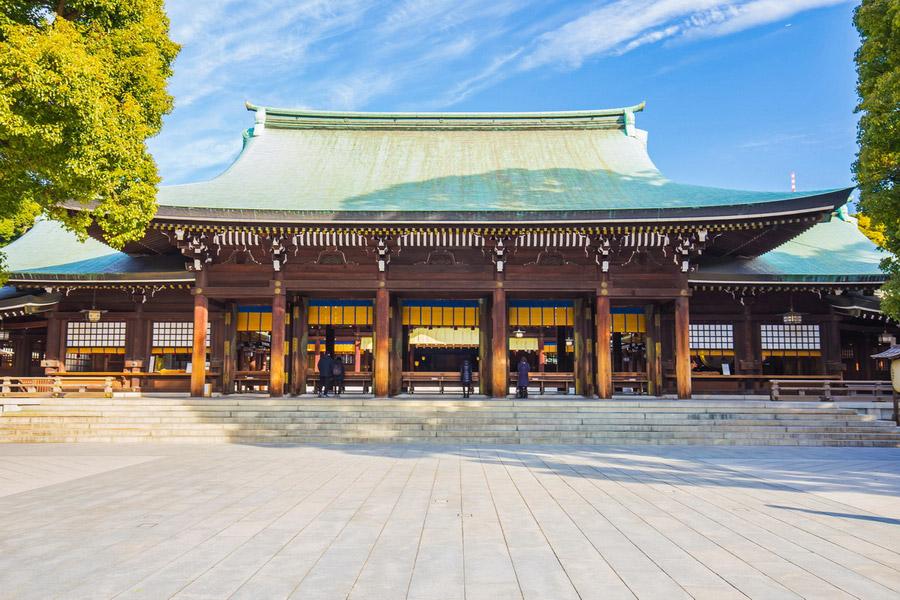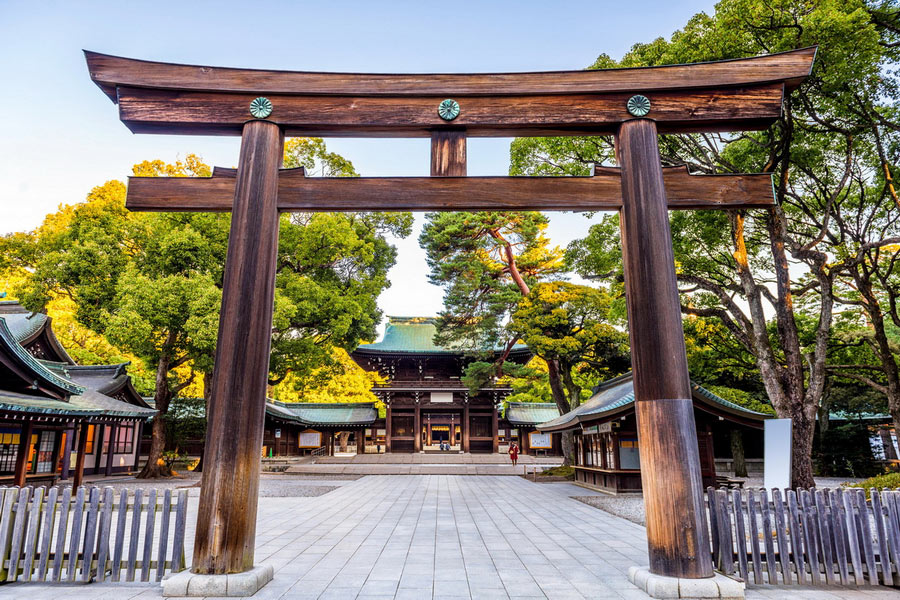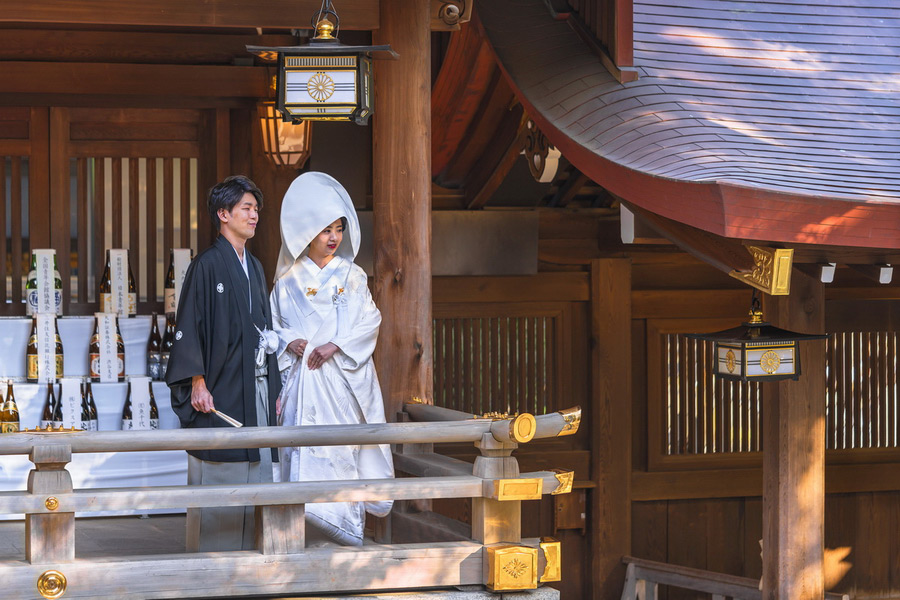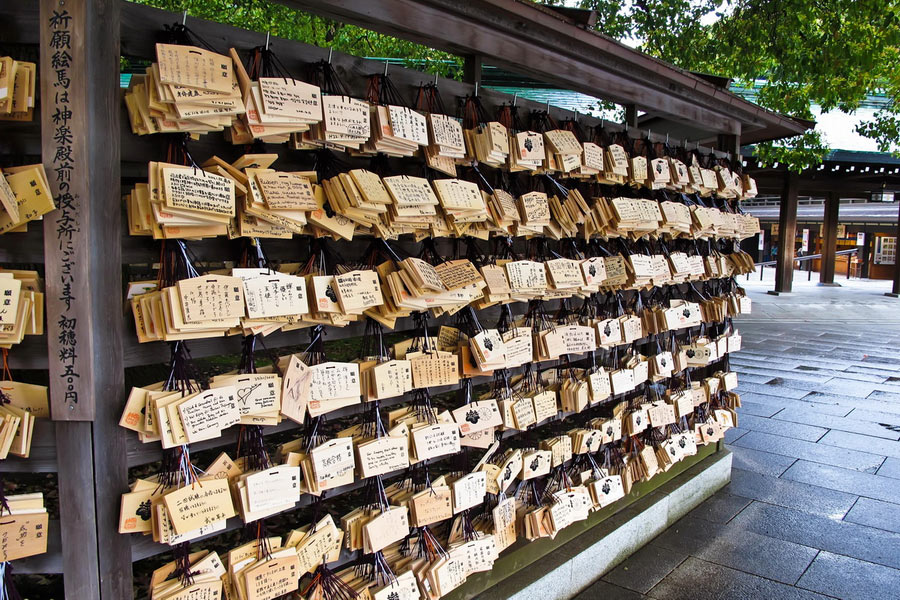
Meiji Shrine (明治神宮, Meiji Jingū) is one of Japan's most renowned Shinto shrines. This Temple, located in the heart of Tokyo's Shibuya special ward, is surrounded by a dense forest, providing a peaceful retreat from the city's hectic pace. The shrine is celebrated for its daily ceremonies, stunning architecture, and scenic grounds.
History
Meiji Jingū was established on November 1, 1920, and is dedicated to Emperor Meiji and his wife, Empress Dowager Shōken. Emperor Meiji's reign is remembered for the sweeping reforms that modernized Japan, transforming it from an isolated feudal society into a leading industrialized country. These changes significantly shaped the Tokyo we know today. The shrine was destroyed during World War II but was rebuilt in its present form in October 1958. Today, it is not only a spiritual center but also a major tourist destination, drawing millions of visitors from around the globe.
Entrance to the Shrine

A large torii gate marks the entrance to the shrine grounds, symbolizing the transition between the earthly and spiritual realms, as well as good fortune in Japan. It is customary to bow slightly when passing under the gate to show respect. As you walk through the entrance, you will see a wall of sake barrels, which are symbolic offerings to the deities and represent the connection between the spiritual and human realms. The shrine complex covers an area of 70 hectares and is home to approximately 120,000 trees donated from various regions across Japan, planted during the shrine's construction.
Meiji Jingū Museum
The Meiji Jingū Museum, designed by the architect Kengo Kuma and opened in 2019, is located near the main shrine. The museum spans over 3,200 square meters on two floors and showcases items used by Emperor Meiji and Empress Dowager Shōken.
Meiji Jingū Inner Garden
The southern part of the shrine grounds features the Inner Garden, which requires an admission fee. The garden is especially popular in mid-June, when the irises are in full bloom. It also has a well named Kiyomasa, after the warlord Katō Kiyomasa, who is believed to have dug it 400 years ago. The well is thought to possess a unique and mysterious positive energy.
Main Sanctuary

The inner sanctum of the Meiji Shrine, dedicated to the spirits of Emperor Meiji and Empress Dowager Shōken, is reserved for religious rituals and ceremonies and is not open to the public. However, visitors can still engage in traditional Shinto practices such as making offerings, praying at the main hall, and purchasing talismans for protection and good fortune. You can also draw a fortune paper (omikuji) or write your wishes on ema boards. Many Japanese people visit the shrine to seek blessings for significant life events such as weddings, the birth of a child, or the start of a major business venture. Visitors can also seek blessings for health, education, or purification from "evil spirits."
Meiji Shrine hosts several important events and festivals. One of the most notable is Hatsumōde which marks the first shrine visit of the New Year. During the first few days of January, over 3 million people visit to pray for good fortune in the coming year. This period is a particularly festive time, with the shrine adorned with celebratory decorations and bustling with activity.
Another popular event is the Spring Festival in April, which coincides with the sakura season. During this time, the shrine and its surrounding forest are covered in a stunning display of pink petals, with various cultural and religious events taking place across the grounds.
Shinto Rituals at the Meiji Shrine

Ema
Write your wishes or messages of gratitude on a wooden plaque and hang it on a designated rack near the main shrine. Cost: ¥500 (¥1,000 on New Year's Day).
Kiganbun
A letter to the kami (deity), which may contain wishes or expressions of gratitude. The letter is placed in an envelope along with a monetary donation and then dropped into the offering box at the main shrine.
Goshuin
A calligraphic certificate commemorating your visit to the shrine, that is stamped in a Goshuinchō (book of seals). Cost: ¥500.
Kigansai (Private Rite)
A Shinto ceremony where individuals can express gratitude or make wishes through prayer. This ritual is open to anyone, regardless of religious beliefs. A donation of ¥5,000 or more per wish is required, depending on the number of participants. Ceremonies are held from 9:30 AM. to 4:30 PM. (every 30 minutes).
Note: Instructions are only provided in Japanese.
How to Get to Meiji Shrine?

The Meiji Shrine is easily accessible via public transportation:
- Take the JR Yamanote or Tokyo Metro Chiyoda subway lines to Harajuku or Meiji-jingūmae Station (1-minute walk).
- Take the Odakyū Line to Sangūbashi Station (3-minute walk).
- Take the JR Yamanote, JR Chūō-Sōbu or Toei Ōedo lines to Yoyogi Station (5-minute walk).
- Take the Tokyo Metro Fukutoshin line to Kito-sandō Station (5-minute walk).
Tips for Visiting the Meiji Shrine
Meiji Shrine. Admission to the shrine is free, and the grounds are open to the public daily from sunrise to sunset. The opening hours vary by month.
Meiji Museum. Admission is ¥1,000 per adult and ¥900 for seniors and children. Entry is also included with The Tokyo Pass.
Inner Garden. Admission costs ¥500.
If you plan to visit only the shrine, allow about an hour. If you also intend to explore the Inner Garden and the Meiji Jingū Museum, keep about two hours free for your visit.
Meiji Jingū Operating Hours
Meiji Shrine
- Winter: Approximately 6:30 AM. to 4:00 PM.
- Spring: Approximately 5:00 AM. to 5:30 PM.
- Summer: Approximately 5:00 AM. to 6:00 PM.
- Fall: Approximately 5:30 AM to 4:00 PM.
Meiji Museum
Open from 10:00 AM. to 4:30 PM. (last entry at 4:00 PM.). Closed on Thursdays.
Inner Garden
Open from 9:00 AM. to 4:30 PM.
The best time to visit the Meiji Shrine is in the morning when it is still quiet and less crowded. On weekends and holidays, the shrine becomes particularly popular, so be prepared for larger crowds.
Meiji Jingū Etiquette
When visiting the Meiji Shrine, it is important to follow certain rules to show respect for this sacred place:
- Purification. When entering the shrine grounds, it is customary to perform a purification ritual at the water ablution pavilion (chōzuya or temizuya). Rinse your hands and mouth to symbolize cleansing before entering the shrine.
- Designated Areas. Eating, drinking, and smoking are only permitted in designated areas.
- Photography and Noise. Taking pictures inside the main sanctuary, where people are praying, is strictly prohibited, as is making noise.
- Stay on the Path. While walking through the forest, do not stray off the designated paths.
- Bicycles. They are not permitted inside the shrine grounds and must be parked at the entrance.
- Do not take flowers, branches, nuts, or any other items from the forest.
- Drones are prohibited.
- Running or exercising on the shrine grounds is not permitted.
- Dress Code. It is recommended to dress modestly, avoiding overly revealing clothing.
Meiji Shrine is not only an important religious site, but also a cultural symbol of Japan that all visitors should visit. It offers a unique blend of the past's traditions and the vibrant life of modern Tokyo. Whether you want to take a peaceful walk through the forest, participate in religious rituals, or a deep dive into the history of the Meiji era, a visit to Meiji Shrine will be an unforgettable experience and a highlight of your trip to Japan.

